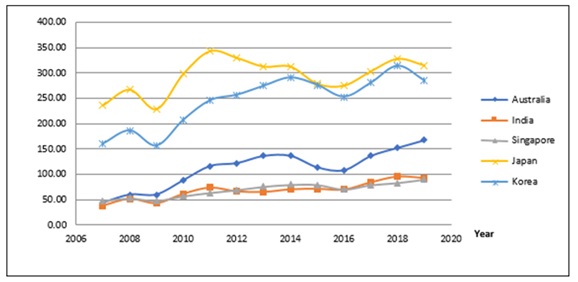

Context
India now plays a crucial role in the Indo-Pacific region. However the rise of China across the Indian and Pacific Oceans challenges the security and especially it poses economic troubles for the country.
Therefore, it is important to examine inextricable Chinese linkages and Indian challenges in the region.
Background
- India’s maritime geography is rich: it has a 7,517-km-long coast line, where lies nine coastal states that are home to a number of ports that handle some 1,400 million tonnes of cargo ever year.
- India being peninsular, its maritime linkages have historically involved trade, religion, and culture; these early associations, however, were severed over time.
- Especially after independence, the focus of India’s foreign outreach had become almost entirely continental.
- In more recent years, since 2014, the focus on maritime capacity development and outreach has grown manifold with national policies being dedicated to the development of the maritime sector.
The Indo-Pacific is a brand-new area in “India’s foreign policy” engagements, describing a transformation in India’s strategic setting increasing its perils solely from its continental frontiers to its maritime area.
Analysis
India’s view on the region
- India has likewise put forth the idea of SAGAR (Security And Growth for All in the Region), holds that the Indo-Pacific is open, free and inclusive, and one that is established upon a collaborative and collective rules-based system.
|
India’s diplomatic participation in the region
|
Why the region is significant for India?
- Economic contribution: The Indo-Pacific region offers enormous economic opportunities, both at the product and factor markets—as the region approximately comprisesof as many as 38 countries, accommodating 65 percent or 4.3 billion of the world population, and accounts for 63 percent of the world GDP.
- Maritime trade: Above 50 percent of the world’s maritime tradeoccurs in this region.
- Intra region partnership: There has been an increased vigour in intra-region partnerships within countries in the Indo-Pacific, and also with extra-regional actors to offset the intensifying presence of China.
How China is playing in the region?
- China has always had a high trade volume with the major Indo-Pacific countries, and this has been rising.
- Over the years, Beijing has strengthened its economic tieswith the Indo-Pacific nations.
- Countries such as Australia, South Korea, and Japan run a trade surplus against China, while India and Singapore run a trade deficit.
- In addition to enjoying a trade surplus, Australia, South Korea, and Japan has China as their largest trading partner, and exports to China contributes significantly to their own economies.
- Therefore, despite political hiccups, it is extremely important for these countries to maintain economic harmony with Beijing—so that there is no consequential decline in Chinese demand for their commodities.

China’s Trade Volume with the major Indo-Pacific countries
Why China is in leading position?
- China’s inextricable linkages with most of the Indo-Pacific nations can be attributed to the key position it holds in the regional value chains.
- This is one of the most important factors which impede the countries in this region in completely diversifying their trade and investments towards other countries in the West, by diverting China.
- For example, Australian agricultural productsare heavily dependent on the Global Value Chains (GVCs), where a large amount of imports come from China.
- In fact, technologically advanced nations such as Japan and South Korea rely on China for manufacturing high-tech components required as inputs in the production of smartphones by companies such as Apple, Xiaomi, Lenovo, and Huawei—these components are mostly assembled in Chinaand then supplied to other nations.
What role is played by India?
- As a major economy and regional player, India has been undertaking efforts to scale up its role in trade and connectivity in the Indo-Pacific.
- In 2020, India’s trade with the selected 20 economies in the Indo-Pacific has grown eight times since 2001.
- While India’s combined trade with these economies was US $33 billion in 2001, it increased to US $262 billion in 2020.
Why India’s economic engagement is still behind?
- India’s economic engagement and leadership in the Indo-Pacific remains limited for a multitude of reasons. These include the
- homogeneity in the service sector, which is centred on IT industries
- lagging FDI flows between India and the Southeast Asian nations
- the lack of big multinational corporations in India that could integrate themselves at various parts of the regional supply chains
Is India sufficient to counter China?
- India’s economic performance in the region is hardly sufficient to counter the growing Chinese influence.
- While India outlines the ASEAN centrality as a core element in its Indo-Pacific strategy and tries to forge closer economic and strategic partnership with the ASEAN member states, India’s volume of trade with ASEAN is nowhere close to China.

China-ASEAN Trade versus India-ASEAN Trade, 2020-21 (in Billion US$)
- For the last 12 years, China has remained ASEAN’s largest trading partner and this year, ASEAN surpassed the European Union to become China’s largest trading bloc.
Why it is important for India to boost ties with ASEAN?
- Boosting India’s economic ties with ASEAN has particular significance in enhancing India’s economic stature in Southeast Asia and the broader Indo-Pacific since economic leverage over Southeast Asia helps China concretize its positionin the region.
Conclusion
Given the importance of Indo-Pacific region in today’s time, it is important for India to shift its approach towards the region.
Therefore, to gain strategic prominence in the Indo-Pacific space, it is imperative for India to enhance its own economic capability and scale up its regional integration efforts.



